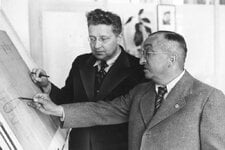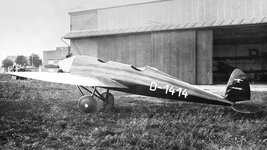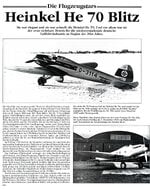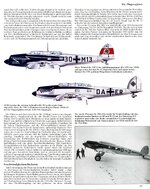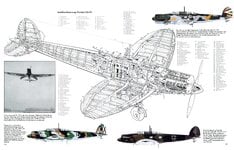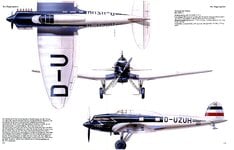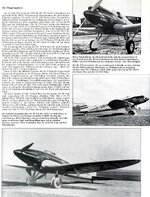Heinkel He 70 (Corrected Version, thanks to Shortround6)
This aircraft was Europe's first high-speed airliner in 1932. The Lockheed Orion from the USA had similar flight performance and made its maiden flight a year earlier. When the world's airliners delivered a cruising speed of 220 km/h, the aerodynamically and aesthetically exquisite 70 was 100 km/h faster. This was due to the sleuthing of industrialist Ernst Heinkel and the Günter twins, whom he had scented. These aircraft builders had built the 'Sausewind' at the Bäumer company in Berlin, which ran 210 km/h with a meager 65 hp, which sent Heinkel into raptures. He drove to Bäumer and bought the twins for his store.
Wind tunnels were still in their infancy at the time, computers had not yet been born - so people were left with arithmetic, experience and a sense of form. The Günters had it all figured out in this respect. The 70 was their first design at Heinkel, and many were to follow.
In 1931, Luft Hansa was looking for a single-engine fast mail plane with a small passenger compartment for 4 people. The Heinkel gang struck, trying out wind tunnels and tricks; among them was smearing the plane with oil and dusting it in flight with a soot-powder-laden fire extinguisher. Countersunk rivets were also used for the first time in Germany.
The whole concept was new: cantilever low-wing with retractable landing gear.
The first production model managed 377 km/h for a short time with the 700 hp of the BMW VI (47 liter displacement, 12 cylinders), which is said to have led to a gruesome binge of joy.
Heinkel knew about the inferior engine development compared to England, they in turn had been startled by the 70. Heinkel and Rolls Royce therefore intended a license exchange, Kestrel engine for He 70, but the Nazis intervened and it had to be left at a single exchange. The Germans loved the Kestrel, the British the 70.
Luft Hansa used the plane for VIP transports mainly. It was also militarized and had some success as a reconnaissance aircraft; it was no good for air combat. The structure of airliners is too weak for that.
The external resemblance to the Spitfire is still striking today. But the 70 was little more than an inspiration to Mitchell, the Spitfire's builder. Mitchell and Heinkel kept up a frank correspondence. The Briton learned that the 70 required extensive and many hours of spackling before painting to achieve a nice finish and many other things that were unthinkable for a fighting machine. So it went a completely different way after molding.
I scanned the pictures from an old 'Aero' booklet. The markings on the vertical stabilizer were changed to avoid trouble.
Wish a lot of fun!
For those who don't speak German: use Google Lens.
This aircraft was Europe's first high-speed airliner in 1932. The Lockheed Orion from the USA had similar flight performance and made its maiden flight a year earlier. When the world's airliners delivered a cruising speed of 220 km/h, the aerodynamically and aesthetically exquisite 70 was 100 km/h faster. This was due to the sleuthing of industrialist Ernst Heinkel and the Günter twins, whom he had scented. These aircraft builders had built the 'Sausewind' at the Bäumer company in Berlin, which ran 210 km/h with a meager 65 hp, which sent Heinkel into raptures. He drove to Bäumer and bought the twins for his store.
Wind tunnels were still in their infancy at the time, computers had not yet been born - so people were left with arithmetic, experience and a sense of form. The Günters had it all figured out in this respect. The 70 was their first design at Heinkel, and many were to follow.
In 1931, Luft Hansa was looking for a single-engine fast mail plane with a small passenger compartment for 4 people. The Heinkel gang struck, trying out wind tunnels and tricks; among them was smearing the plane with oil and dusting it in flight with a soot-powder-laden fire extinguisher. Countersunk rivets were also used for the first time in Germany.
The whole concept was new: cantilever low-wing with retractable landing gear.
The first production model managed 377 km/h for a short time with the 700 hp of the BMW VI (47 liter displacement, 12 cylinders), which is said to have led to a gruesome binge of joy.
Heinkel knew about the inferior engine development compared to England, they in turn had been startled by the 70. Heinkel and Rolls Royce therefore intended a license exchange, Kestrel engine for He 70, but the Nazis intervened and it had to be left at a single exchange. The Germans loved the Kestrel, the British the 70.
Luft Hansa used the plane for VIP transports mainly. It was also militarized and had some success as a reconnaissance aircraft; it was no good for air combat. The structure of airliners is too weak for that.
The external resemblance to the Spitfire is still striking today. But the 70 was little more than an inspiration to Mitchell, the Spitfire's builder. Mitchell and Heinkel kept up a frank correspondence. The Briton learned that the 70 required extensive and many hours of spackling before painting to achieve a nice finish and many other things that were unthinkable for a fighting machine. So it went a completely different way after molding.
I scanned the pictures from an old 'Aero' booklet. The markings on the vertical stabilizer were changed to avoid trouble.
Wish a lot of fun!
For those who don't speak German: use Google Lens.
Attachments
Last edited:

